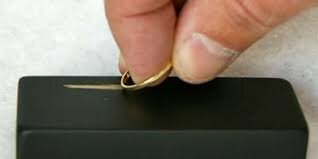How do you melt down gold?
Materials
First you start with the material.. this will either be pre-owned jewellery from a client for a repurposing project, or new metal from a supplier. All my materials are always 100% recycled, even if I buy them “new” straight from the supplier. I would normally get this as grain, but it also comes in the form of sheet or wire.
Testing
If I am using your existing jewellery, I’ll need to test the gold to check the purity. There are industrial testing machines which are used in the Assay office, but in a workshop we use a touchstone and a variety of acids to ascertain how much gold is in the metal.
1064 degrees of heat!
Now it is time to add some heat. 1064 is the melting temperature of gold – pure 24 carat gold to be specific. Gold is normally mixed with other alloys such as silver, copper and palladium to achieve the desired carat.
And back to solid
After you’ve finished staring at the glowing molten liquid gold, you pour it in to an ingot mould and it instantly solidifies!
The top side of the ingot is rough and bumpy whilst the underside is smooth and you can see the gold in all it’s shiny butteriness.
At this point, the newly formed ingot can be turned into wire, sheet or whatever other shape you need for the creations that are about to be made!




